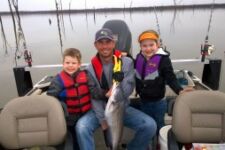Snagging spoonbill, also known as paddlefish, at Grand Lake is an adventure anglers from across the country dream about.

The prehistoric paddlefish, also known as spoonbill catfish, is a sight to behold.
With its shark-like body and distinctive rostrum (that’s the paddle!) that accounts for one-third of its length, this monster fish has remained unchanged for over 300 million years.
And one of the best places in the world to snag these gentle giants is right here at Oklahoma’s Grand Lake.
Read on for more info on snagging spoonbill at Grand, but let’s go ahead and get this out of the way…
Grand Lake Paddlefish Guides
Let’s cut right to the chase… one of the best ways to make sure you get on a big ol’ spoony (as we call them around here) is to hire an experienced Grand Lake paddlefish guide.
There are plenty in the area, but here are some featured guides (and, yes, they have paid to be included here):


Lance’s Fishing Guide Service

Chasin’ Tail Guide Service
Understanding Paddlefish at Grand Lake
Paddlefish, often called spoonbill due to their distinctive, spoon-shaped snout, are one of the most intriguing catches an angler can hope for.
The Appeal of Paddlefish
These prehistoric fish, roaming our waters for millions of years, offer a unique challenge and thrill.
Their size alone is impressive, with adults often weighing over 100 pounds and stretching several feet in length.
But it’s not just their size that captivates anglers and even non-anglers; it’s the experience.
Snagging a paddlefish requires skill, patience, and a bit of luck, making each catch a rewarding achievement.
Add in the fact that it feels like you are touching history, and it’s an experience you won’t soon forget.
Why Grand Lake?
Grand Lake O’ the Cherokees, nestled in Northeast Oklahoma, is a hotspot for paddlefish snagging for several reasons.
Firstly, it boasts one of the largest, most concentrated populations of paddlefish in North America.
This makes Grand Lake an ideal destination for anglers looking to target these giants.
The lake’s diverse habitat, including deep open waters and flowing tributaries, provides perfect conditions for paddlefish, especially during the winter months and their spawning runs in the spring.
Grand Lake’s management practices, including regulated snagging seasons and conservation efforts, also ensure that the paddlefish population remains healthy and accessible to anglers.
The local community, including guides, bait shops, and accommodations, is also geared towards supporting anglers in their pursuit of not just the local spoonbill population, but all of the fish species that call Grand Lake home.
It doesn’t matter if you are an experienced snagger or new to the sport, Grand Lake offers an unparalleled opportunity to engage with one of the most extraordinary fishing experiences in the country.
Preparing for Your Snagging Adventure

Before heading out on your quest to snag a paddlefish at Grand Lake, understanding the rules and regulations and being prepared for what you are about to do is crucial for a rewarding experience.
Licenses, Limits, and Regulations
Every angler looking to snag paddlefish at Grand Lake needs to have a valid Oklahoma fishing license and a specific paddlefish permit, which can be obtained online or at local sporting goods stores.
It’s important to make sure you are familiar with the daily and annual limits, as well as the designated days for catch-and-release versus catch-and-keep, ensuring your adventure adheres to local conservation efforts and regulations.
Specific paddlefish rules and regulations can be found HERE on the Oklahoma Wildlife Department website.
Essential Gear for Snagging
The right gear is essential for snagging paddlefish, known for their size and strength. Your toolkit should include:
- A heavy-action rod, typically 10 to 12 feet long, to withstand the weight and fight of a paddlefish.
- A large capacity reel paired with a 50 lb. test line, ensures durability during the snagging process.
- Large treble hooks (10/0 to 12/0 size) and weights ranging from 5 oz. to 1 lb., tailored to whether you’re trolling or bank fishing.
Snagging Techniques and Strategies
How to Snag a Paddlefish
Snagging doesn’t involve luring the fish with bait but rather hooking them as they swim.
This technique requires casting your line into areas where paddlefish are likely congregated, then steadily reeling in, hoping the hook catches onto a fish.
It’s a method that demands patience, precision, and the right conditions to be successful.
Of course, booking a trip with a reputable Grand Lake guide will take care of all of this as they will help you with your licensing requirement and provide all of the necessary equipment – and expertise!
Winter and Spring Are The Best Times To Snag
The seasons play a crucial role in the life cycle of paddlefish, which means certain times of year are better for your snagging adventures than others.
Typically, winter and spring are the prime seasons. Here’s why:
The Winter Draw
Winter is a great time to snag paddlefish at Grand Lake for several reasons, making it a popular season and one of the reasons Grand Lake becomes a destination in the winter months.
- Concentrated Populations: During the winter months, paddlefish tend to congregate in specific areas of Grand Lake, making them easier to locate. This behavior is partly due to the water temperature and the fish’s spawning habits. With paddlefish more concentrated, the chances of successfully snagging one increase – big time!
- Reduced Competition: Winter fishing often sees fewer recreational boaters and anglers on the water, meaning less competition and better fishing conditions. This allows for a more enjoyable and focused snagging experience.
- Predictable Movement: Paddlefish movements become more predictable in the colder months as they seek out optimal water temperatures and conditions. This predictability aids guides and anglers in choosing the best spots for snagging.
- Pre-Spawn Activity: Leading up to their spring spawning run, paddlefish start to become more active. Winter offers a unique opportunity to catch these fish as they prepare for spawning, particularly towards the end of the season.
- Ideal Water Conditions: The water levels and flow rates in rivers feeding into Grand Lake can create ideal snagging conditions. Cold water increases the paddlefish’s metabolic needs, often bringing them closer to the surface or into more accessible areas for anglers.
- Unique Experience: Snagging paddlefish in winter offers a unique outdoor experience, different from typical warm-weather fishing. The challenge of the cold and the thrill of snagging a large paddlefish combine to make winter outings memorable. But, rest assured, the guides at Grand Lake do have enclosures to help keep you more comfortable.
Spring Spawning Run
Spring is arguably the most exciting time to snag paddlefish at Grand Lake.
As temperatures rise, paddlefish begin their annual spawning run up the tributaries of Grand Lake, including the Spring and Neosho Rivers.
This predictable pattern of movement brings them closer to the surface and into more accessible regions for snagging.
The increased activity and higher density of fish during this period significantly boost the odds of a successful snag – although if you choose to bank fish in the area of Twin Bridges State Park, be ready for the crowds.
Plus, hey, it’s Spring… the days are getting warmer and longer. What can be wrong with that?
Why Hire a Local Guide?
While the basics of snagging can be self-taught, hiring a local guide can dramatically enhance your snagging adventure.
Guides provide:
- Expert knowledge of current conditions, ensuring you’re fishing in locations with the highest likelihood of success.
- Instruction on refining your snagging technique, catering to both beginners and experienced anglers.
- All necessary gear, optimized for snagging paddlefish, which is great for those new to the sport or visiting from out of town.
- A comprehensive, stress-free experience that allows you to focus on the thrill of the catch, with guides handling navigation, equipment, and even the proper catch-and-release practices to support conservation.
Whether you’re a seasoned angler or new to the sport, the guidance of a local expert can make all the difference in snagging one of these Grand Lake giants.
Where To Stay On Your Snagging Adventure?
If you are not local to the Grand Lake area or region, you’ll need to find a place to stay.
There are plenty of places to stay in Grove, which is the commercial hub of the Grand Lake area, and home to the Wolf Creek Park fishing facility, which is likely where you would meet a guide if you hire one.
And even if you aren’t hiring a guide, Wolf Creek Park is the premier launch facility on Grand Lake. Some say in the country.
So Grove has a good selection of hotels and a variety of places to stay.
Shangri-La Resort on Monkey Island is another great option, especially if you are looking to spoil yourself a little bit when you aren’t on the water.
Plus, the nightlife on Monkey Island is regionally famous, that’s for sure.
Finally, if a private home vacation rental at Grand Lake is more your speed – there are plenty of options to choose from. Check out this Guide to Vacation Rentals at Grand Lake for more on that.
So, there you go… there is a lot of information up there, but hopefully, you can find something that helps you get ready for your spoonbill-snagging adventure at Oklahoma’s Grand Lake.




Leave a Reply